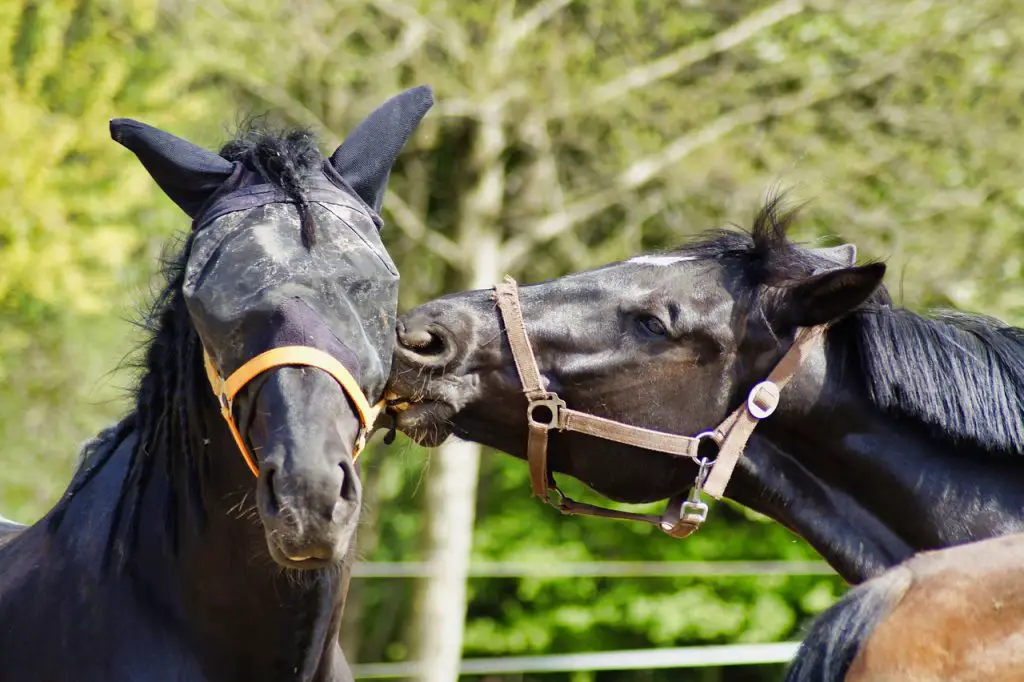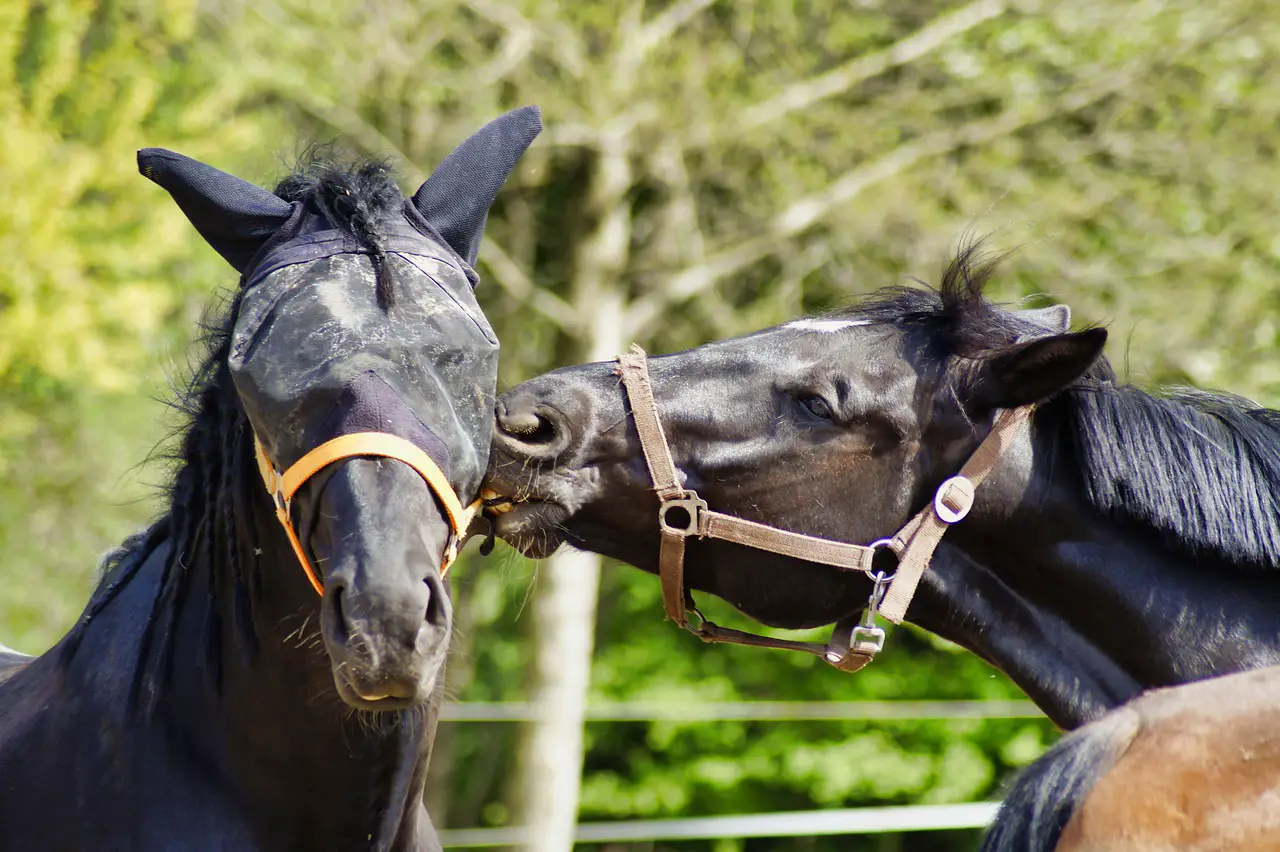Last Updated on February 24, 2022 by Allison Price
You might have wondered what the owner thought if he saw a horse in a blindfold frolicking in the field. You might have even seen horses racing with strange eye covers at a racetrack.
Why are horses’ eyes covered? To stop flies biting their eyes, horses’ eyes are often covered with transparent mesh. The horse can see and hear fine, but the fly-mask prevents flies gathering on their face.
Don’t be alarmed if you have ever seen a horse with strange eyewear. He is probably not blindfolded. These are possible explanations.
Horse Vision
Horses see the world differently to humans. Horses, being prey animals, rely on their monocular sight to search for potential predators. To focus on their prey, predators use binocular sight.
- Monocular vision Both eyes are used independently and are usually placed on the sides or back of the animal’s head. Although this gives them a wider field, it also limits depth perception. Horses can see up to two objects simultaneously on each side, but not behind them. It is important to never approach horses from behind.
- Binocular Vision: Animals who rely on binocular vision primarily use their eyes together to create 3-dimensional images. Although their field of vision is limited and depth perception is enhanced, this is important for predators trying to catch moving targets.
Horses rely mainly on their monocular vision. Horses can see 350 degrees around themselves, whereas humans can only see 190 degrees. They rely on their monocular vision for most of this, but they can also use their binocular sight to focus on the objects directly in front of them.
Horses have to raise and lower their heads in order to concentrate on what is important. This is why jumping horses often raise their heads when approaching jumps. (source)
Limiting the field
Driving horse with blinkers
Sometimes, a driver or rider may wish to restrict the horse’s vision. This can be for many reasons:
- Working carriage horses in cities may become distracted by the movement and sights around them. The best way to get rid of distracting or scary obstacles is to focus your eyes forward.
- An excitable racehorse may become distracted or nervous if he is confronted by his rivals.
- Unexperienced riders may cause a lesson horse to become upset or grouchy. He may be more relaxed if he has a narrower field of vision.
Blinders and blinkers are two ways that the field of vision might be restricted. The horses are still able to see clearly in front of them, so don’t be alarmed.
There are horses, carriages, and blinkers, oh my!
For thousands of years, humans have used horses and other draft animals as pull-waists in wagons and plows. Although the overall setup has changed over time, it is still the same.
Horses pulling carriages, sleighs, plows, or other vehicles will typically wear a bridle or harness. To give the driver control over the horse’s head, long reins attach to the bridle. The harness attaches the horse to the pulling vehicle. (source)
Plastic plates may be used to cover the eyes of the horse’s bridle. These plates are known as blinkers or blinders. Although he can still see well, his field of vision is restricted to the area directly in front.Driving horses with blinkers
Imagine a cart or carriage looking like a horse. It’s a large box with big spinning wheels that follows you everywhere you go. This can be frightening for nervous horses. Even though most experienced carriage horses are able to get used to these strange contraptions, it might still be important to keep the horse’s attention in front of him.
The History of the Blinker
It is possible that the original purpose of blinkers was to protect horses’ eyes from being struck by the reins. This may have been due to the placement of harness straps.
As harness designs improved to meet the growing demand for carriage horses, blinkers also became fashion statements. (source)
Decorative coaches and carriages became status symbols. They were often decorated with gold and had their family crests attached to the blinkers.
Coach pulling is no longer an elite sport for draft horses. Farmers needed horses that could not only handle their ploughs but could also jump fences to hunt rabbits on weekends.
Handlers began to look for ways to manage lighter, more agile breeds. They also decorated the blinkers of their horses to imitate the fashion choices of the upper classes.
Blinkers were a great way to calm a nervous horse in a busy city. They also allowed you to show off your fashion sense. Blinkers made it easier for horses to be calmed in busy cities.
At the Racetrack.
Racehorses are often seen wearing visors or hoods. These soft hoods can be fitted with plastic cups of varying sizes and colors.
It depends on where you are from, blinkers can be seen as a way to “cop-out” a horse on the track.
In America, blinker covers are very common and many of America’s most famous racehorses used them. His blue and white checkered blinker cover was worn by Secretariat as he raced to his Triple Crown victory in 1973.
Although trotting harness racehorses are accustomed to wearing blinker hoods and transparent goggles, there is a lot more happening in their field of view. Some horses will wear full visor shields and transparent goggles to keep them safe from the flying mud.Race horse wearing full mesh goggles
Fly Masks do not have blindfolds
A fly mask is a cover that appears to be a blindfold on a horse that you see out in the field. Fly masks can be fashionable hoods that cover horses’ faces with fine mesh.Flying on horses wearing a fly mask
Fly masks are available in many styles and colors.
There are many options, in fact. I have compiled my favorite fly masks all in one post.
Fly masks can be worn by horses for many reasons.

- Protection against flies and other biting bugs. Flies can be a nuisance and carry diseases. Horses use their tails for flies removal, but sometimes they need additional protection.
- Protection from the sun. Some horses are more sensitive than others to the UV rays from the sun. Horses with lighter-colored eyes and horses who live in sunny areas may require extra protection. Owners may opt to provide UV protection for their horses if they spend too much time outdoors or are suffering from moon blindness.
- Rehabilitation from illness or injury. Protect delicate areas of the skin that are healing from injury or trauma with fly masks. Horses suffering from equine-recurrent uveitis, also known as moon blindness, often have inflammation and dilation in their pupils. A fly mask can be used to protect their delicate eyes from flare-ups.
This mare has an eye infection caused by flies. A fly mask now helps keep her eyes clear.Same horse with fly mask.
Blindfolds
Horses, as prey animals, rely on their sight to be comfortable in their environment. A horse without a hood, or any other type of eye covering is likely not wearing a blindfold. There are certain circumstances where a horse must be blindfolded completely.
- When loading or trailering into a start gate. Horses are able to see well at night, but can struggle to move from bright areas to low-light areas. It can be scary to have a dark trailer or an enclosed gate for starting. To practice loading and unloading these items, trainers might use a blindfold. However, it is important to establish trust first.
- In an emergency. In Anna Sewell’s classic Black Beauty, there’s a famous scene: The barn is burning and the horses are afraid to go. The groom blindfolds the horses and leads them to safety. A blindfold can calm nervous horses, especially if they are around someone they trust.
- Health and medical needs. Horses who have to undergo surgery or any other type of medical procedure may need to be blindfolded. An anxious horse might not be able to understand the complicated-looking equipment. He may find it easier to handle if he does not see it. To protect the healing eyes of a horse with eye or facial injuries, he may need to be blindfolded.
It is probably not a blindfold!
A horse can see fine even if his vision is partially obscured. Blindfolds that are truly complete are rare. You’re most likely looking at fly masks or blinkers.
You should consider using blinkers to protect your horse’s vision. However, some horses may respond well to having their vision restricted.
Proper training and care are essential when you use a blinker on your horse.


